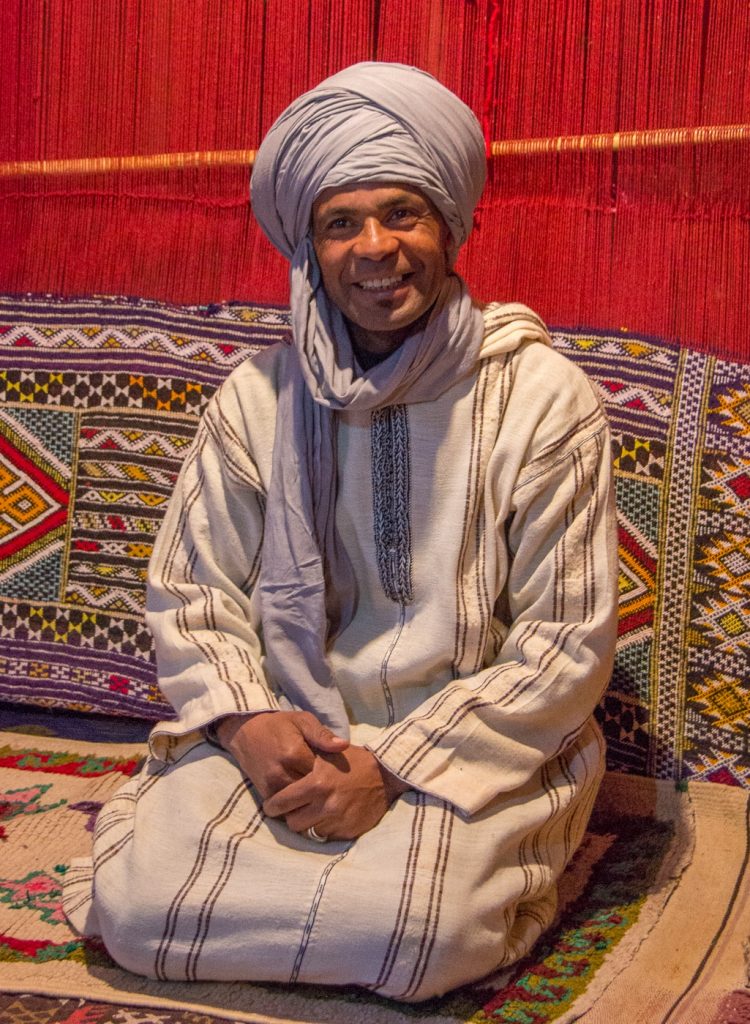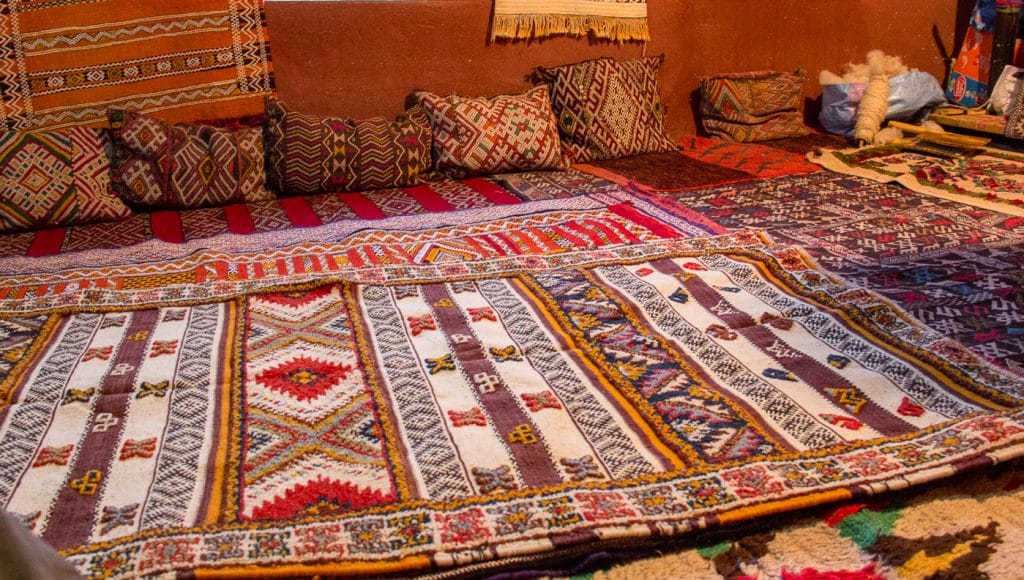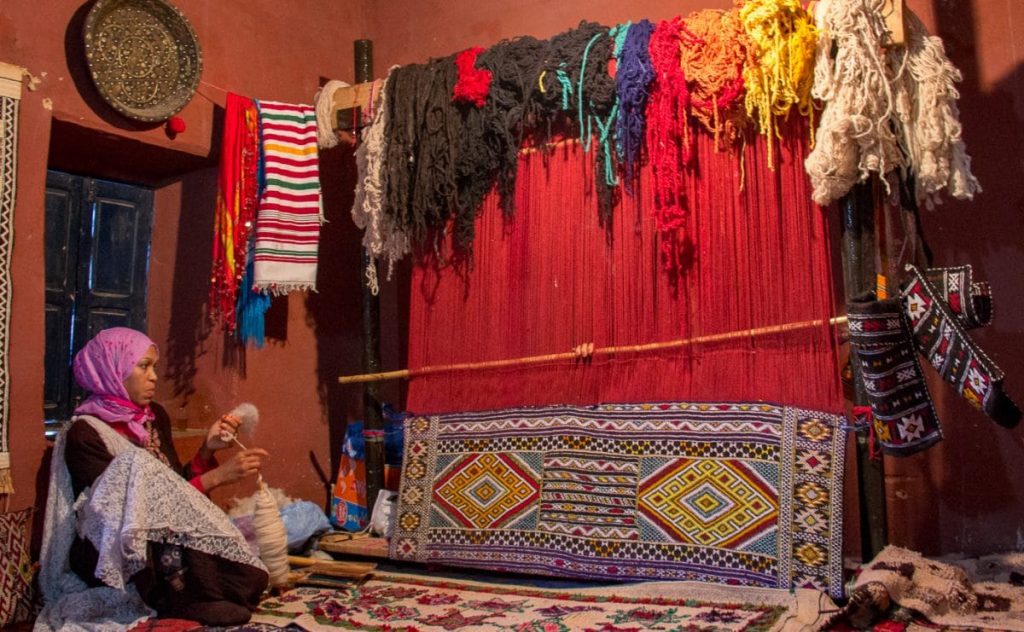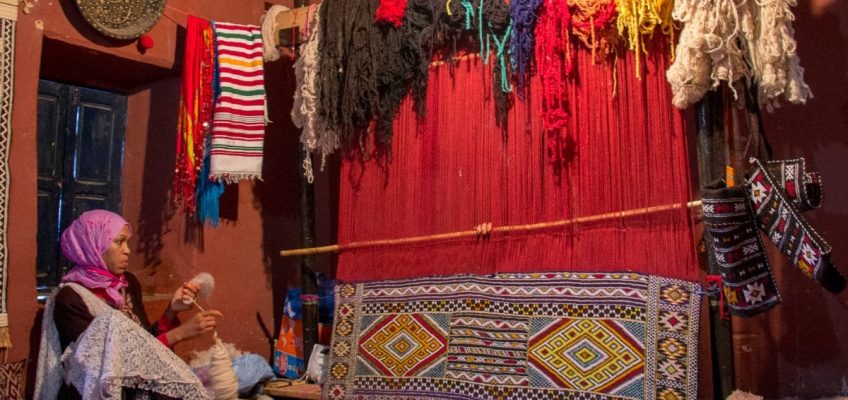Thinking of buying a Moroccan rug? Learn about the materials, dyes, and patterns that affect the price of a rug and a few tips on bargaining. We also tell you a couple of places to shop to avoid the high pressure sales pitch.
On our tour through the Moroccan desert, we stopped at the local rug cooperative in Tinghir to learn more about Berber culture and rug making. The local Berber ladies use their skills making traditional Berber rugs as a source of income.
In Morocco, there are a lot of touts in the souks selling rugs (not as bad as Turkey though) and generally because they are so common we just ignore them as it is hard to know who to trust without knowing much about Moroccan rugs, and hard to know what a fair price is for a rug. How would you know if you are getting ripped off?
Moroccan Rug Cooperative in Tinghir
The rug cooperative in Tinghir offers the perfect place to learn about Moroccan rugs without the high-pressure sales pitch! The entire process- carding and spinning the wool, dying, and weaving is completed here.
You can meet the ladies who make the rugs. The cooperative provides a way for these ladies to use their skills to make an income. Offering a flexible schedule, the ladies come to weave whenever they have free time. The looms are available, and they work in a comfortable, social environment.

Making a Moroccan Rug by Hand
Berber women learn to make rugs for their own homes. Rugs are everyday, household items used not only on the floor but also to sit on and for wall hangings. Using wool from the family sheep or camel, carding and spinning it by hand, using natural dyes bought at the market or growing near their homes, Berber women make beautiful handmade rugs for their home. Yellow and orange dyes are from henna and saffron, blues dyes from indigo. The same process is used at the rug cooperative.
Types of Moroccan Rugs
The patterns, colors and materials used for making rugs vary by region and tell local stories. Heavy sheep wool rugs, warm in the winter, are common in mountain areas. Camel and agave rugs are good in warmer climates including the desert areas of Morocco and used by the Taureg (or Touareg) people, another traditional tribe living in the desert areas of Morocco. Rugs of certain patterns and materials were referred to as Taureg or Berber rugs, when we were learning about Moroccan rugs at the Coop.
Some rugs are double sided. The pattern looks the same from either side. Some rugs have a winter and a summer side. The winter side is thick wool and the summer side “the back” of the rug is flat to be cooler. Finding a rug that will look great in your home is not difficult.
What are Morocco Rugs made of?
Rugs are made of all-natural materials. Wool from sheep, goats and camels are used. Goat and baby camel wool are more expensive.
Silk rugs, made from cactus silk, threads created from the agave cacti, are also used for rug making in Morocco. (A great option for a rug if you are a vegetarian or just opposed to animal products.) Silk rugs tend be softer and shinier. We found a silk cooperative, making rugs, scarves and other household items in the medina in Fez (very near Palais Amani where we stayed.)
If you purchase a traditional Moroccan rug, it is an all-natural product with no chemicals used. A handmade rug will last more than a lifetime, you will pass it on to your children. If you like the patterns and workmanship, a Moroccan rug is an excellent souvenir from your trip.

What Determines the Price of a Moroccan Rug?
Three things affect the price of a Moroccan rug, the size, the materials, and the patterns.
We have discussed materials above, due to scarcity of the natural materials some wool and silk rugs have a higher price.
The patterns include both the color and the intricacy of the pattern. The more intricate the pattern, the longer the rug takes to make, and the more skill required to make it. The density of the pattern is often measured in knots per square inch. The higher the number of knots, the higher the price. Because silk thread is thinner, silk rugs can be denser than wool. Durability also impacts the price.
Some dyes are more expensive than others. Yellow colors made from saffron will be the most expensive due to the cost of the saffron.
A large rug with a less intricate pattern can be less expensive than a small rug with a complex pattern or made of silk. Size and complexity also influences how long the rug takes to make. A handmade Berber rug can take anywhere from 10 days to several months to make.

Visiting the Rug Cooperative in Tinghir
There is no pressure to buy a rug during your visit to the rug cooperative in Tinghir. You can just learn how rugs are handmade in Morocco, take photos, enjoy a mint tea and continue your journey. There is no actual shop at the coop and they view their role as one of education to visitors as well as providing an income to the ladies in the community. Many of the rugs made at the cooperative are sold to other shops in Morocco.
If you are interested in purchasing a rug from the coop, all the rugs have price tags. This is Morocco and I suspect bargaining would be the norm. The advantage of buying from the coop is the money stays in the community. There is no middleman.
Wondering how to get your rug home? They can ship anywhere in the world or package your rug into an unbelievably small bundle for you to take with you.
The gentleman running the coop in Tinghir is Razouk El Mahjoub, (he is the gentleman in the video and pictured above). The name of the coop: Tissage Des Tapis Berbere Nomade which roughly translates “Weaving of Nomadic Berber Rugs”. It is in Tizgui, Tinghir. It appears on Google maps as the “Carpet Cooperative” if you enter “Tizgui, Tinghir“- the description of the location on his business card is 13 km from Tinghir and 600 m from Todra Gorge. You can contact Razouk at +212 6 424 78 527 or 0627 566 647, or by email berbere.nomode.todra@ hotmail.com (no space before the hotmail.com)

Where is the Best Place to Buy a Rug in Morocco?
If you are not in Tinghir, there are several rug cooperatives in Fez. (And I am sure there is some equivalent in Marrakech, but we did not visit one.) The rug shop in Fez we visited, Dar Zarbia S.A.R.L., is a government owned cooperative which our guide took us to on our walking tour of the Fez medina.
Each rug had a price on a sticker on the back of it. That is the starting price. Bargaining is all part of the fun in Morocco and they do expect you to bargain and not pay the first price quoted. A general guideline is the purchase price is closer to 50-60% of the starting price. If you are not happy you can walk away. Once you agree verbally on a price you should complete the purchase.
Some of the rugs for sale are also “used” or second hand. (Remember what I said about lasting forever!) This should be disclosed to you and the bill of sale should state it is used. Keep in mind used is not the same as antique.
No GST or VAT is payable on a rug as they are considered a piece of art, a one of a kind, not available for purchase in your home country.
If you are at all interested in purchasing a rug in Morocco do a bit of research on line before you go. There is plenty of information about how to identify quality and the experience of purchasing a rug in Morocco.


Leave a Reply